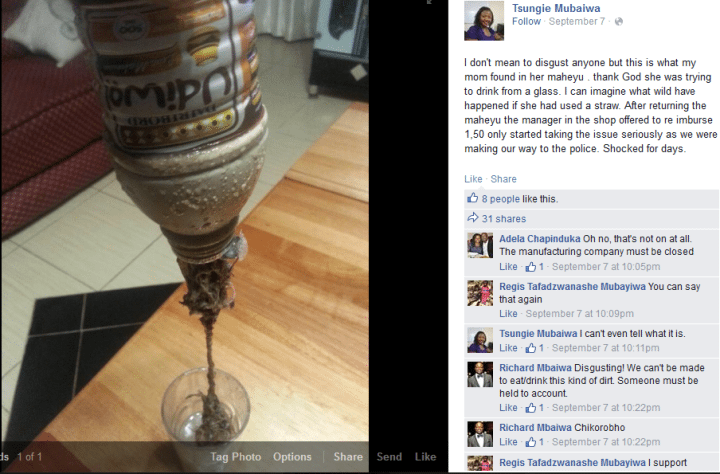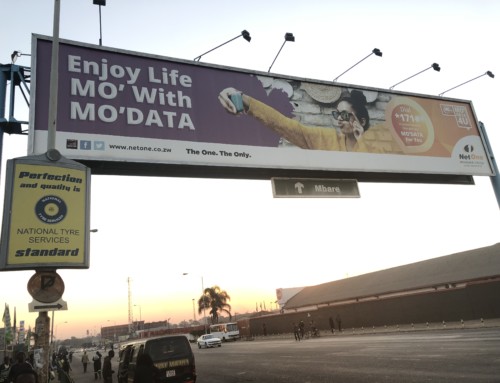Hello people! I hope that I find you well. I am well myself thank you. A few weeks ago Dairibord Zimbabwe got embroiled in a fiasco on social media. A (former) customer Tsungie Mubaiwa posted a picture of some ‘foreign’ material coming out of her mother’s favourite drink, Pfuko-Udiwo Maheu as she tried to pour some of the sweet juice into a glass. The picture is nothing short of horrifying I tell you. Refer to the featured picture on this article along with some comments from Tsungie’s friends. While people were busy crucifying Dairibord and calling it all sorts of names I was busy thinking, does Dairibord have a public relations strategy? If it has a public relations strategy, is it good? I watched from the sidelines (and like the Pharisees I threw a stone or two myself) to see how Dairibord would react to the onslaught in order to determine whether or not they had a sound public relations strategy in place. Later on in this article I will also give a few pointers as to what you can include in your own public relations strategy to make is incident-proof, if there is such a term.
So, does Dairibord have a sound public relations strategy? According to The Chartered Institute of Public Relations (CIPR) ‘PR is about reputation – the result of what you do, what you say and what others say about you. PR is the discipline that looks after reputation, with the aim of earning understanding and support and influencing opinion and behaviour. It is the planned and sustained effort to establish and maintain goodwill and mutual understanding between an organisation and its publics.’
With this in mind let us take a look at the statement that Dairibord released in response to the allegation that is on the cover photo of this article (the photo above):
We will now take a look at the responses from the customers (to the statement that Dairibord made) below:
Going back to the definition of public relations.
- The result of what you do – Dairibord’s reputation was damaged even more by the statement that they issued as you can see by the responses that were made by the customers. Only 5% of the responses were in favour of Dairibord
- What you say – As you can see with people’s comments Dairibord was very defensive, it offered no apology to the ‘victim’ and it went on to suggest that sabotage was the cause of the incident. The vague nature of the last statement left people to think that Dairibord was pointing a finger at the customer when they could have been talking about competitors
- What others say about you – It is clear from people’s comments that Dairibord’s reputation was damaged greatly by both the initial incident and the response that they gave
Based on this incident I can say that Dairibord needs to do some work on its public relations strategy. What we are seeing here is not the problem, but they are symptoms of the problem. Much like when one is coughing, coughing is not the problem but it is the symptom. A cough can be caused by various problems like a flu, dust etc. Since we are in diagnostic mode let us take a look at other symptoms that Dairibord is showing in terms of managing its public image and engaging with some of its stakeholders.
I searched for Dairibord on Google and this is what I found:
Notice where I circled with red ink? It says ‘Joomla – the dynamic portal engine and content management system’. Such text should not be visible to us, the customers. This means that whoever created their website using a Joomla template did not finish creating the website. If someone had checked they would have picked this up by now. This is a symptom that Dairibord might not have someone who consistently manages their public image
I then went onto the website proper and this is what I found:
Did you notice the red circle that I put there? When I opened the website an error message was displayed which informed me that a certain component of Java had expired (on the website). This is what is causing what I saw in the red circle. This means that the person who is maintaining the website might not be doing so, or doing so well enough. This is another symptom of the problem. The quality of the pictures on the website also points towards Dairibord not really prioritising its public image
My next stop was on Dairibord’s Twitter page: 
On the Twitter page you can see the cover page which has the ‘Shop, Gallop and Win’ promotion still displayed. This was part of the OK Grand Challenge which ended sometime in June. This shows that this page is not being monitored consistently. Also notice that the last Tweet was posted on August 7, almost 2 months ago. The quality of the cover photo can be improved. All this points to the fact that Dairibord is not managing its public image well. A company the size of Dairibord has 514 followers on Twitter
I then visited their Facebook page to take a look at how things are going there:
Dairibord’s Facebook page has 30446 likes but most of their posts are subscribed to by very few people. In this example only one person engaged with the page at a high level. If you go on the page you will notice that for most of their posts this is what is happening (low engagement). This is a symptom of a problem. When you reach out to people and they do not ‘holler’ back there might be an issue with your public relations. The Pfuko incident just served to bring to the fore issues that have been affecting Dairibord (and possibly its bottom line) for quite some time
Based on the mini investigation that I conducted what do you think of the situation? Does Dairibord have a public relations strategy? If it does is it a good public relations strategy? My take is that they may not have a deliberate public relations strategy (under their marketing strategy). If they have one I am of the opinion that it can still be improved. Next let us look at what they could do in order to improve in this aspect.
I will speak on the assumption that they have a Business Continuity Plan in place. The Pfuko incident is definitely something that affects business continuity. I am just looking at the public relations side of things, the business continuity plan would be a whole different ball game. Here are some of the things that they could consider in order to have a good public relations strategy that deals with situations such as the Pfuko incident.
-
- Make special provisions for the media: I am not sure whether or not they held a press conference for this but it would have been a good idea in a situation like this. To this end you should have a meeting room that is always ready to hold such conferences. It might be used for other things on a daily basis but it should always be ready to hold a press conference at short notice. Provide contact details to various media houses and authorities to ensure that they can contact you at any time should there be an issue. Preferably the media should be able to get through to the public relations point man. The public relations point man should also maintain good relations with the media in order to be able to spread a certain message swiftly. In the case of the Pfuko incident the issue came through the media and Dairibord should have sent a response from where the message came from using their resources to overwhelm the complainant (in a tactful way of course). From the research that I conducted Dairibord seems to only have responded on Facebook. I did not see a response on Twitter (their last tweet was on August 7, 2015). I also did not see anything else on Herald, their website and on the rest of the internet. The idea would be to put their responses (like a well written statement) on the most popular platforms in order to get the word out quicker as opposed to waiting for them to post it themselves.
- The spokesperson/public relations point man should handle all communications: The reason why I say this is to ensure that there is consistency in terms of how an issue is addressed. Consistency will ensure that your response is more believable. In the case of Dairibord more than one person gave a response and since the responses implied different things it became difficult for people to believe what Dairibord had to say after that. Take a look at the picture below:
On the picture’s caption you can see that the first person who talked to Tsungie about the matter was the ‘store manager’. The manager aggravated the issue by offering a refund of $1.50. Dairibord’s spokesperson was supposed to have been alerted about the issue and offered a solution as opposed to the manager. This is a symptom that this might not have been covered in the public relations strategy on how to deal with communications made by members of your distribution network
Dairibord’s spokesperson (the one that was there when I last checked), Emeldah Shoko should have handled the issue from the beginning. The shop manager should not have tried to do come up with a resolution himself but should have escalated the issue to Dairibord with Emeldah Shoko taking over. The result was that the shop manager apologised to Tsungie for the mishap in a manner that seemed to lay the blame on Dairibord and then Dairibord released a statement that seemed to lay the blame on Tsungie, the customer. That’s when things really heated up. The fact that Dairibord addressed people from behind a veil made people feel like the company did not care about the issue. The response from Dairibord did not have a ‘face’ i.e. a name. A good example of a company that puts a face to all its official communication is Multichoice which always puts the name of their public relations manager, Liz Dziva on their messages. It is also good to note that the spokesperson should be trained well in issues to do with public relations.
3) Reduce the potential number of contact points: When a crisis arises there should be a protocol in place that will ensure that all the stakeholders, especially the employees get communication in line with how they should respond to the issue in the case that they are asked by relatives, friends or enterprising journalists who might look for a weak, uninformed link in the chain. The idea is to ensure that everyone who is not supposed to respond to the issue does not respond as this might create gaps like the one we saw in the second point above. For example you could ensure that everyone that is associated with your company says ‘no comment but you can get more information from (provide contact details of those in charge of the response’. This ensures that the number of possible contact points for the media will be reduced. I will draw your attention to one or two comments that were made by someone who might be associated with Dairibord. Take a look at the picture below:
Note the comment made by Sabastain Eddington Mhondiwa Mupunhairi. He says ‘to you customers wthout you we are nothing’. He seems to be associating himself with Dairibord as their employee. This cannot be verified and that is not the point. The point is a public relations strategy should make sure that only those that are appointed to speak do the speaking. Imagine if this guy was indeed an employee and it could be verified. We would have quoted him and taken Dairibord to the cleaners
When you have control over who says what then you will be assured that a consistent message will be delivered to your stakeholders until the situation is under control.
4) Monitor the environment: You should constantly monitor the environment in order to know what is being said about your brand at all times. Dairibord’s response time shows that it might not have a system that it uses to monitor the media. For example on Twitter you can just type in the name of your company or products and you can get a good idea of what people are saying about your brand. This should be done on a daily basis across as many contact points as possible. See the examples below:
After searching using the word ‘Dairibord’ on Twitter you can see the various posts that are being made by people in relation to Dairibord. This is a very cheap way of monitoring the media. A firm with resources like Dairibord can use more advanced (and expensive) methods to monitor the environment. It is not only good for public relations, the information you get from watching the media can help you to adjust your strategy etc.
Take a look at the picture below that will show you that even if Dairibord has not yet responded (again) to the Pfuko issue people were left with a bad taste in their mouth as they are now talking about Dairibord’s yoghurt. This is when you know that an issue has affected the company brand as a whole. The next post also lends some credibility to the fact that Dairibord might not be as thorough in their manufacturing processes as they say they are meaning the Pfuko incident could be Dairibord’s fault. It seems from the picture below that they also do not prioritise their public image as they did not respond to the allegations made by another customer in the picture:
The customer asked Dairibord if this is a new flavour. As you can see on the top of the cup it is written ‘Banana’ and at the bottom of the cup it is written ‘Peach’. Two different flavours on the same cup represents a process flaw. Dairibord did not respond. My theory is they missed the Tweet because they last posted on Twitter on August 7. Issues like this need to be dealt with so monitoring the environment is a critical aspect of public relations strategy
Dairibord responded to the first post that was made by Tsungie after approximately 48 hours. If they had been monitoring the media constantly they might have responded a bit earlier. When you have a good public relations strategy in place with the right tools being utilised to monitor the environment a response will come within an hour, 3 hours tops. This will increase the chances of a situation being brought under control.
5) Language and tone: Last but definitely not least I will touch on the language and tone. How you respond in situations like these reflects on your strategy. It defines how good you were in whatever you were planning in the background. Always remember that public relations is a psychological game and as such you should play on people’s emotions all of the time. The first thing that you should do is get a feel of how people feel about an issue so that you know what to say. A customer’s perception is their reality so your response should prioritise the customer’s perception over the reality on the ground. In order to gauge people’s perceptions Dairibord could have gone to Tsungie’s original post and read people’s comments. Based on the findings Dairibord could have crafted a message that dealt with these perceptions and at the same time maintained its position. As you realised Dairibord not only decided to go against people’s sentiments but did so with a tone that made them sound ignorant. I will not elaborate much on this as the repercussions of that approach were clear for all to see in this saga.
So, there we have it! The symptoms in the first part of the article would lead me to think that Dairibord does not have a good public relations strategy and could do with having a look at that area. Public relations is all about your image and the various symptoms such as the incomplete website show you that public image might not be much of an issue to them. I then touched on the things that they could look at in order to craft a good public relations strategy, I hope you managed to jot down a few notes there. You can also tell us about your own ideas on public relations strategy below. What do you think? Does Dairibord have a good public relations strategy?
Thanks
Ruvimbo







Great article Ruvimbo!
Your analysis of the issue was pretty in depth and as a loyal Dairibord customer, I only hope that they will draw lessons from this incident. The way they handled the issue was rather flawed and painted a really bad picture of the way they handle their customers’ queries.
Thank you very much for the compliment Tariro.
I hope that they learnt as well. I think that one of the major reasons why this happened is because Dairibord has not had a lot of competition for a long time. Kefalos and the likes have entered the scene but there is still need for someone of their own size to challenge them and give them a run for their money. If they have a proactive approach to business they will start to close the gaps right now. This incident is a symptom which shows that there might be other problems which are affecting the whole company. A public relations strategy usually falls under the marketing strategy so they might want to look at that aspect of their business as well.
A great research & write up Ruvimbo.
What a pity that we will never know how that thing got in the bottle, Dairiboard’s investigations aside.
But as a result, what does Dairiboard’s public say?
We read here social media comments from former (recent) customers. So this summaries what paying customers are saying & doing = leaving.
2 issues I pick from the press statement:
1. In view of the opaque plastic that Dairiboard uses for packaging, a drinker will only see any foreign object after opening. So in short Dairiboard is telling all its customers not to open & drink away from its premises. Any drinking should be in the presence of a Dairiboard employee (as eye witness).
2. Also I did not know that there are some objects that are found only outside Dairiboard’s premises (in such an open environment as ours), hence Dairiboard’s vehement assertion that the object was not from its premises. This point is further reinforced by one of the customers’ facebook response, ‘There is no manufacturing process without flaws.’ As if Dairiboard, being one of the many users of manufacturing processes, does not know this.
My point on these 2? A mature & strategically planned response was required.
Summarising the whole development:
1. The way Dairiboard had to be threatened with police action, before it acquiesced by refunding $1.50.
2. The way it comes out unapologetic and guns blazing in the press statement.
3. Poor/unprofessional online presence (both website and social sites).
4. More than one person (3?) gave a response & contradicting each other.
Am sorry to say 3 and 4 are signs of being disorganised. 1 and 2 show arrogance. In a nutshell Dairiboard’s overall behaviour shows managerial immaturity. It is not surprising therefore that such an old organisation like this has no PR strategy. They may say they have it. But we need remember that the definition of PR also entails what its publics are saying about the company.
A strategy is a game plan that has been put into position to cover any eventuality. A relevant portion of it here is Customer Service recovery. It shows readiness to quickly neutralize negative situations. We do not see this in the case of Dairiboard. This is why a genuine complaint degenerated into a social media shouting match. How sad.
Thank you very much Taurai, it is always good to read some kind words from you.
I would not blame those customers for leaving because this issue, proven or not, raised a lot of questions about the firm’s manufacturing process. To compound the issue Dairibord has not yet come back to us with the results of the investigation. Well at least I have not yet come across the response (I have been looking for it). It also reminded people of what happens when our food is bring manufactured. As they say, if you like your food, make sure you do not know how it was made.
I like the way you mentioned the issue about the opaque plastic, that is a new angle for sure. They are refusing to at least be neutral about the issue. In essence they are saying that their manufacturing process delivers 100% of the time, which I think in reality is highly unlikely. Sure if the cleaning cloth could not have been found on Dairibord’s premises as they claim then are they saying that they do not possess cleaning clothes on their premises. What do they clean with then?
Your summary is very accurate. What also worries me is the effect that this has probably been having on Dairibord’s bottom line and the country as a whole. Questions that can now be asked are:
1) Is Dairibord’s strategy good enough to take the company to the next level if we are seeing such symptoms? Is the company as big as it could have been? Is it making as much revenue as it can? I am seeing an opportunity for growth for the company here because it seems like it is not getting everything right meaning if they attend to some issues they can make more revenue. This could be evidence of the fact that Dairibord’s stakeholders are losing out i.e. not getting as much in terms of returns from the firm as they could be getting. This is also true of many other local companies.
2) From a national standpoint are such approaches to business not hindering the growth of our country as a whole? Looking at your mission to help our nation Taurai is this not a cause for concern that loopholes in strategies are leading to firms possibly not making much revenue as they should which leads to the government getting less in terms of tax dollars? Are such approaches to business not slowing down the growth of our GDP and consequently the recovery of the nation from recession? A question that I am afraid to even ask myself is how long has this been happening in Zimbabwe? Since the 00s? Since the 90s? Since before that? If so where could our beloved country be right now if we actually did things right from way back?
Thanks for that over-arching question Ruvimbo.
If Dairiboard & other companies were doing things RIGHT from year 1, where would they be in terms of size and revenue? You go further, by extension, how much would our country’s GDP have grown ever since? Where would Zimbabwe be in the region, in Africa and the global space?
I know for sure we would have maintained our hegemony as the manufacturing hub as well as the bread basket of this sub-region. I also know we would be where (or even further than) South Africa is today (having a recognisable African foot print).
Having said that, on to your other question. What can I (we) who want to bring up the country again do about this morass?
The 1st thing we need to have flowing in all, which we have also discussed elsewhere (you and I) is to have an entrepreneurial culture. If we had entrepreneurial owners as well as entrepreneurial managers at Dairiboard, we would not have this rot. If we had people who had passion for their work, and not just being in love with their job titles, we would not have people screaming at companies via social sites. We would have tactfully turned all these dissenting voices into brand ambassadors and evangelists long ago. Hence our bottom line would be uber good.
You are welcome Taurai
Very true. The fact that we have few to no entrepreneurial individuals in these companies also points to the recruitment policies that prevail in these firms. Recruitment has been responsible for a lot of the damage that has occurred in many companies in years past. Human resources departments have been recruiting people who cannot perform for years now. This phenomenon combined with the fact that it was not easy to get rid of people (owing to our labour law which has since been altered) who performed poorly meant that companies ended up being stuck with under performers. It is the job of the human resources department to ensure that we have the perfect mix of employees in a company, including those who are entrepreneurial in nature, but this is not being done (deliberately at least). They are probably not aware of the fact that they should have such a mix in the company structure.
Wonderful staff there
Thank you very much Evans! It is good when people say such encouraging things. I will continue to produce more articles for you!
The PR was not well done but the packaging for Dairibord is best in class and the containers are not recycled. I wonder how that stuff found its way into that bottle.
Yes Gari that is probably the case since they are ISO certified. So if you were Dairibord how would you get us the customers to trust you again, in terms of the packaging? I would consider transparent bottles for the Pfuko maheu at least until the dust has completely settled. This would send a message that we want people to trust us that is why we would want people to ‘see through’ us.
hats off to this unnamed company,l complained about their and they send me a carton to replace one packet
Hello. Would you mind sharing with us which company this is?
http://www.linkbucks.com/IRWR
That is really attention-grabbing, You are a very professional blogger.
I’ve joined your rss feed and look ahead to
seeking more of your wonderful post. Additionally, I’ve shared your website in my
social networkshttp://www.marinirseo.web.id/
Thank you very much for sharing the article. God bless you.
Very nice post. I certainly love this site. Keep it up!
Thank you very much Lavonda. I appreciate the kind words.
Well researched. Good piece!
Thanks a lot Rumbi, I am glad that you approve.
“I truly appreciate this blog article.Really looking forward to read more. Much obliged.”
This was a good analysis. I am from a technical side heavily and work in the food manufacturing space. What Dairibord suffered is very common in the food industry… Sabotage. In Food safety systems we have a strategy called Food Defence system to identify all the security risks inherent in the process. Sabotage does take place inside the factory. An employee who is not happy will carry out such, a supervisor who did not perform a line clearance will result in such being missed. At the bottle supplier such is possible that someone was cleaning the conveyor that cloth was forced into the bottle unnoticed. Since they don’t have a camera scanning system at the bottle wash station, this can go through. It’s true at the filling station the cloth won’t go through but upstream of the process the bottle is open to the environment.
WOW! That is shocking. Even if you are not happy how does one get the strength to endanger other people like that? It would take something much bigger than a scrub to derail a strong brand. Yet one customer could end up in a hospital, or worse. For interest sake, why are there no cameras at the wash station?